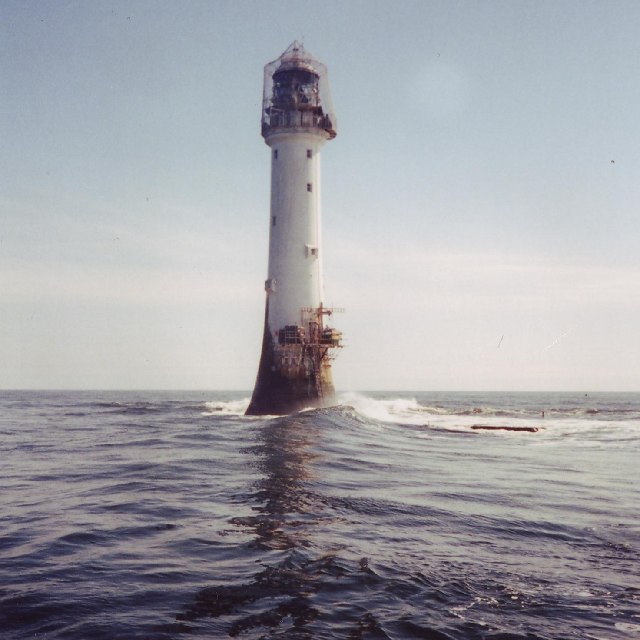bell (E)
cloche (F)
campana (I)
campana (S)
Glocke (G)
vailima, samoa

We’ll get to the tropical island paradise of Samoa in a minute. But first, to the Bell Rock Lighthouse, pictured above, the world’s oldest surviving sea-washed lighthouse. It’s located on the east coast of Scotland, 11 kilometers east of the Firth of Tay, north of Edinburgh. Built between 1807 and 1810, it stands 35 meters high and its light is visible from 56 kilometers inland. Another famous sea-washed lighthouse is La Jument, located off the Island of Ushant, in Brittany, France. That lighthouse (or phare in French) is famous for photographs taken by Jean Guichard during a storm in December 1989.
Bell Rock Lighthouse was built on top of Inchcape Rock, a treacherous reef that was directly in the way of ships navigating the River Tay into the city of Dundee (yes, the city where that delicious orange marmalade was invented). The rock was given the name Bell because, supposedly, the Abbot of Aberbrothock (sounds like a name from Outlander) placed a bell on the rock, which was later stolen by a notorious pirate named Ralph the Rover. Ironically, Ralph’s ship wrecked on the rock the following year. The legend made it into a poem by Robert Southey.
The construction of the lighthouse was of such high quality that the structure has not been replaced or adapted in more than 200 years. Particularly remarkable, given that during construction and to this day, the rock is only uncovered at low tide while covered by about 5 meters of water at high tide. The lighthouse’s lamps were replaced in 1843 and were automated in 1988. It was the Northern Lighthouse Board which approved the construction of the Bell Rock Lighthouse and still monitors it today.
At the time of approval, the board was composed of a number of members of the Stevenson clan. The clan’s most famous member today is Robert Louis Stevenson, the author of Treasure Island, Strange Case of Dr. Jekyll and Mr. Hyde, Kidnapped, and A Child’s Garden of Verses. But, over a number of generations, the Scottish Stevenson clan, who specialized in marine engineering, were known for their construction prowess. Family members designed and built ninety-seven lighthouses around Scotland, including Bell Rock Lighthouse, and also built harbors, canals, bridges and other transportation infrastructure.
Robert Louis Stevenson (who, while not adopting a pen name, changed his name from Robert Lewis Balfour Stevenson) suffered from poor health his whole life. He didn’t enter the family marine engineering business, although he did accompany his father on lighthouse inspections during holidays from university. He eventually decided on a career of letters; studied the law; and, in 1887, wrote about not following in his family’s footsteps in the poetry collection Underwoods:
Say not of me that weakly I declined
The labours of my sires, and fled the sea,
The towers we founded and the lamps we lit,
To play at home with paper like a child.
But rather say: In the afternoon of time
A strenuous family dusted from its hands
The sand of granite, and beholding far
Along the sounding coast its pyramids
And tall memorials catch the dying sun,
Smiled well content, and to this childish task
Around the fire addressed its evening hours.
Stevenson wrote some of his more famous works while living in Bournemouth, England at Skerryvore, a house named after a lighthouse built by his uncle. Despite his ill health, he traveled extensively to Europe and the United States, perhaps guided by his quote: “to travel hopefully is a better thing than to arrive.” In June 1888, Stevenson chartered a yacht and set sail with his family from San Francisco, headed for Hawaii. The maritime environment was good for his health and he traveled around the Eastern Pacific for several years, spending time in the Hawiian Islands, the Gilbert Islands, Tahiti, New Zealand, the Samoan Islands and Australia. He wrote extensively about his experiences.

In December 1889, Stevenson and his family arrived at the port of Apia in the Samoan Islands and decided to stay put. He and his wife Fanny purchased more than 300 acres in Valima and built the island’s first two-story house, now the Robert Louis Stevenson Museum. Stevenson took the native name Tusitla (Samoan for teller of tales). The frequent arrival of British, German and American warships in Samoa highlighted to Stevenson the precarious political situation of Samoa and caused Stevenson to become a reporter and a political activist. Sadly, Stevenson died in Samoa of a stroke at the age of 44 in December 1894. Five years after his death, the Samoan Islands were partitioned between Germany and the United States.